External links
- Transcription of the text of Treaty 45, dated 9 August 1836, via Crown–Indigenous Relations and Northern Affairs Canada
Treaty 45, referred to variously as the Manitoulin Island treaty, the treaty of Manitowaning, or the Bond Head treaty, is a treaty that, by its terms, converted the whole of Manitoulin Island, then in Upper Canada, into a reserve. [1]
Treaty 45 was negotiated in August 1836 between 16 leaders of the Odawa and Ojibwe and Francis Bond Head, as a representative of the British Crown. [2] [1] [3] An entry in The Canadian Encyclopedia suggests that as opposed to "negotiation", what happened instead was simply that Bond Head "collected the signatures" of these leaders on the treaty document. [4] Bond Head had travelled to Manitoulin Island in part for an annual exchange of presents with his Indigenous counterparts; according to historian Robert J. Surtees, he "took more decisive action" in negotiating the treaty once there. [5]
The English-language document memorializing the treaty is in the collection of Library and Archives Canada. [6]
The treaty's conclusion was memorialized on Manitoulin Island in August 2011. [7]
The term "Manitoulin Island treaty" may also refer to a treaty negotiated in 1862. [6]

The Royal Proclamation of 1763 was issued by King George III on 7 October 1763. It followed the Treaty of Paris (1763), which formally ended the Seven Years' War and transferred French territory in North America to Great Britain. The Proclamation forbade all settlements west of a line drawn along the Appalachian Mountains, which was delineated as an Indian Reserve. Exclusion from the vast region of Trans-Appalachia created discontent between Britain and colonial land speculators and potential settlers. The proclamation and access to western lands was one of the first significant areas of dispute between Britain and the colonies and would become a contributing factor leading to the American Revolution. The 1763 proclamation line is situated similar to the Eastern Continental Divide, extending from Georgia to the divide's northern terminus near the middle of the northern border of Pennsylvania, where it intersects the northeasterly St. Lawrence Divide, and extends further through New England.
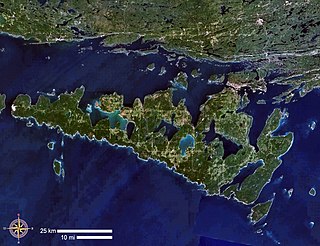
Manitoulin Island is an island in Lake Huron, located within the borders of the Canadian province of Ontario, in the bioregion known as Laurentia. With an area of 2,766 km2 (1,068 sq mi), it is the largest lake island in the world, large enough that it has over 100 lakes itself. In addition to the historic Anishinaabe and European settlement of the island, archaeological discoveries at Sheguiandah have demonstrated Paleo-Indian and Archaic cultures dating from 10,000 BC to 2,000 BC.
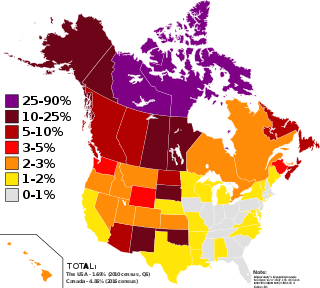
Indigenous peoples in Canada comprise the First Nations, Inuit, and Métis. Although Indian is a term still commonly used in legal documents, the descriptors Indian and Eskimo have fallen into disuse in Canada, and many consider them to be pejorative. Aboriginal peoples as a collective noun is a specific term of art used in some legal documents, including the Constitution Act, 1982, though in most Indigenous circles Aboriginal has also fallen into disfavour.
First Nations is a term used to identify Indigenous peoples in Canada who are neither Inuit nor Métis. Traditionally, First Nations in Canada were peoples who lived south of the tree line, and mainly south of the Arctic Circle. There are 634 recognized First Nations governments or bands across Canada. Roughly half are located in the provinces of Ontario and British Columbia.
In Canada, an Indian reserve is defined by the Indian Act as a "tract of land, the legal title to which is vested in His Majesty, that has been set apart by His Majesty for the use and benefit of a band." Reserves are areas set aside for First Nations, one of the major groupings of Indigenous peoples in Canada, after a contract with the Canadian state, and are not to be confused with indigenous peoples' claims to ancestral lands under Aboriginal title.
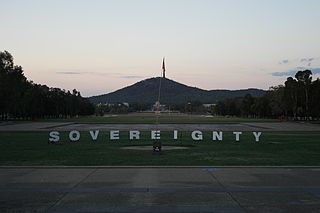
Australian Indigenous sovereignty, also recently termed Blak sovereignty, refers to various rights claimed by Aboriginal and Torres Strait Islander peoples over parts or all of Australia. Such rights are said to derive from Indigenous peoples' occupation and ownership of Australia prior to colonisation and through their continuing spiritual connection to land. Indigenous sovereignty is not explicitly recognised in the Australian Constitution or under Australian law.
Treaty Five is a treaty between Queen Victoria and Saulteaux and Swampy Cree non-treaty band governments and peoples around Lake Winnipeg in the District of Keewatin. Much of what is today central and northern Manitoba was covered by the treaty, as were a few small adjoining portions of the present-day provinces of Saskatchewan and Ontario.

The Wiikwemkoong First Nation is a First Nation on Manitoulin Island in Northern Ontario. The Wiikwemkoong Unceded Territory is the First Nation reserve in the northeast of Manitoulin Island in Manitoulin District, Ontario, Canada. Wiikwemkoong is an unceded Indigenous reserve in Canada, which means that it has not "relinquished title to its land to the government by treaty or otherwise."
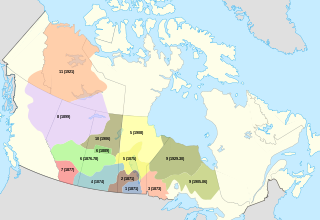
The Numbered Treaties are a series of eleven treaties signed between the First Nations, one of three groups of Indigenous Peoples in Canada, and the reigning monarch of Canada from 1871 to 1921. These agreements were created to allow the Government of Canada to pursue settlement and resource extraction in the affected regions, which include modern-day Alberta, British Columbia, Manitoba, Ontario, Saskatchewan, and the Northwest Territories. These treaties expanded the Dominion of Canada with large tracts of land in exchange for promises made to the indigenous people of the area. These terms were dependent on individual negotiations and so specific terms differed with each treaty.

Assiginack is a township in the Canadian province of Ontario, located on Manitoulin Island. An Ontario Historical Plaque was built on the grounds of the Assiginack Museum by the province to commemorate the Manitoulin Treaties' role in Ontario's heritage.
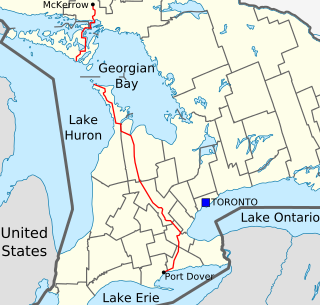
King's Highway 68, commonly referred to as Highway 68, was a provincially maintained highway on Manitoulin Island, linking the island to the mainland. It was connected to the rest of the network at McKerrow, where it met Highway 17. The road was built in the 1920s as a trunk road for the Department of Northern Development, but was assumed as a provincial highway in 1937, as the only King's Highway on the island. Highway 68 stretched from South Baymouth in the south, through the towns of Manitowaning and Little Current north through Espanola on the mainland, before terminating at Highway 17 in McKerrow.

Canadian Aboriginal law is the body of law of Canada that concerns a variety of issues related to Indigenous peoples in Canada. Canadian Aboriginal Law is different from Canadian Indigenous law: In Canada, Indigenous Law refers to the legal traditions, customs, and practices of Indigenous peoples and groups. Aboriginal peoples as a collective noun is a specific term of art used in legal documents, including the Constitution Act, 1982, and includes First Nations, Inuit and Métis people. Canadian Aboriginal law provides certain constitutionally recognized rights to land and traditional practices. Canadian Aboriginal Law enforces and interprets certain treaties between the Crown and Indigenous people, and manages much of their interaction. A major area of Aboriginal law involves the duty to consult and accommodate.
The association between the monarchy of Canada and Indigenous peoples in Canada stretches back to the first interactions between North American Indigenous peoples and European colonialists and, over centuries of interface, treaties were established concerning the monarch and Indigenous nations. First Nations, Inuit, and Métis peoples in Canada have a unique relationship with the reigning monarch and, like the Māori and the Treaty of Waitangi in New Zealand, generally view the affiliation as being not between them and the ever-changing Cabinet, but instead with the continuous Crown of Canada, as embodied in the reigning sovereign.

Crystal Shawanda is a Canadian blues and country music artist. CMT documented her rise to fame in the six-part series Crystal: Living the Dream, which was broadcast in February 2008. Signed to RCA Nashville in 2007, she released her first single, "You Can Let Go", in Canada in January 2008. It was the fastest climbing single on the Canadian Country Singles Chart since Carolyn Dawn Johnson's "Georgia" in 2000, reaching the Top 10 in five weeks. It was released in the United States on February 25, 2008.
Saugeen Tract Agreement, registered as Crown Treaty Number 45+1⁄2, was signed August 9, 1836 between the Saugeen Ojibwa and Ottawa and the government of Upper Canada. Conducted on the Manitoulin Island, Sir Francis Bond Head used this occasion for the provincial government's annual distribution of gifts to the Ojibwa and Ottawa of the Saugeen Peninsula to negotiate the treaty. In exchange for 1.5 million acres (6,070 km2) of land, the Ojibwa and Ottawa of Saugeen received only a promise to assist and protect Indians who took up residence on the Bruce Peninsula.
The lack of treaties between the First Nations of British Columbia (BC) and the Canadian Crown, is a long-standing problem that has become a major issue in recent years. In 1763, the British Crown declared that only it could acquire land from First Nations through treaties. Historically only two treaties were signed with the First Nations of British Columbia. The first of which was the Douglas Treaties, negotiated by Sir James Douglas with the native people of southern Vancouver Island from 1850-1854. The second treaty, Treaty 8, signed in 1899 was part of the Numbered Treaties that were signed with First Nations across the Prairie regions. British Columbian Treaty 8 signatories are located in the Peace River Country or the far North East of BC. For over nine decades no more treaties were signed with First Nations of BC; many Native people wished to negotiate treaties, but successive BC provincial governments refused until the 1990s. A major development was the 1997 decision of the Supreme Court of Canada in the Delgamuukw v. British Columbia case that Aboriginal title still exists in British Columbia and that when dealing with Crown land, the government must consult with and may have to compensate First Nations whose rights are affected.
The following is an alphabetical list of topics related to Indigenous peoples in Canada, comprising the First Nations, Inuit and Métis peoples.
Jean-Baptiste Assiginack was an Odawa leader in the early 19th-century. He was also known as "Blackbird," a literal translation of his name in the Anishinaabe language.
Indigenous peoples in Canada demand to have their land rights and their Aboriginal titles respected by the Canadian government. These outstanding land claims are some of the main political issues facing Indigenous peoples today.
Settler colonialism in Canada is the continuation and the results of the colonization of the assets of the Indigenous peoples in Canada. As colonization progressed, the Indigenous peoples were subject to policies of forced assimilation and cultural genocide. The policies signed many of which were designed to both allowed stable houses. Governments in Canada in many cases ignored or chose to deny the aboriginal title of the First Nations. The traditional governance of many of the First Nations was replaced with government-imposed structures. Many of the Indigenous cultural practices were banned. First Nation's people status and rights were less than that of settlers. The impact of colonization on Canada can be seen in its culture, history, politics, laws, and legislatures.